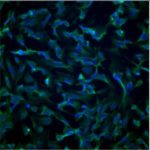Link to Pubmed [PMID] – 20808780
PLoS ONE 2010 Aug;5(8):e12388
In mammals DNA methylation occurs at position 5 of cytosine in a CpG context and regulates gene expression. It plays an important role in diseases and inhibitors of DNA methyltransferases (DNMTs)–the enzymes responsible for DNA methylation–are used in clinics for cancer therapy. The most potent inhibitors are 5-azacytidine and 5-azadeoxycytidine. Zebularine (1-(beta-D-ribofuranosyl)-2(1H)- pyrimidinone) is another cytidine analog described as a potent inhibitor that acts by forming a covalent complex with DNMT when incorporated into DNA. Here we bring additional experiments to explain its mechanism of action. First, we observe an increase in the DNA binding when zebularine is incorporated into the DNA, compared to deoxycytidine and 5-fluorodeoxycytidine, together with a strong decrease in the dissociation rate. Second, we show by denaturing gel analysis that the intermediate covalent complex between the enzyme and the DNA is reversible, differing thus from 5-fluorodeoxycytidine. Third, no methylation reaction occurs when zebularine is present in the DNA. We confirm that zebularine exerts its demethylation activity by stabilizing the binding of DNMTs to DNA, hindering the methylation and decreasing the dissociation, thereby trapping the enzyme and preventing turnover even at other sites.

